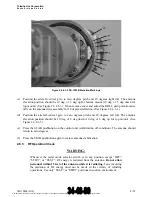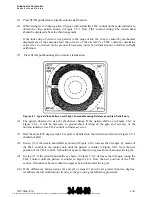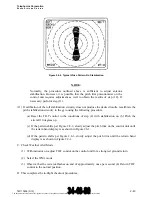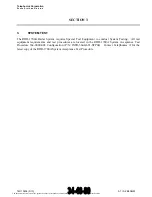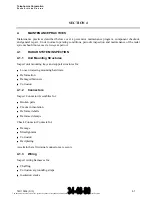
Telephonics Corporation
R
A D A R
S
Y S T E M S
D
I V I S I O N
2-40
TM113806 (3/10)
I.
Adjust the TILT control up (+ degrees) in small increments until a clear picture develops of any
local weather. Close-in ground targets may also appear in the display. (In bottom-mounted
antenna installation, this test may not be possible.)
J.
Repeat TILT control adjustment to check remaining ranges.
K.
Change the RADAR mode to SRCH. Observe that SRCH appears in the upper left corner of the
display, and the fault display remains off. Press PULSE (PW) pushbutton to select short, medium,
and long pulse and to select auto-search mode. At each position, the corresponding identifier
should follow the SRCH annunciation on the display (i.e., SRCH S, SRCH M, SRCH L, or
SRCH A).
L.
Set the range to 20. Observe that the distance between rings is identified in the lower left corner
(MKS 5) or centered along the left side. Index range selector to 10, 5, 2.5, 1.25, and 0.625 NM
and note that the range rings are identified properly in each range.
M. Set the RADAR mode to BCN and the range to 20. Press BCN pushbutton. Observe that the
characters BCN ONLY appear in the upper left corner of the display. The fault indicator should
be off and the display should be free of all noise and ground clutter. If a beacon station of 9310
MHz is within range, a beacon reply may be observed on the screen.
2.8 FLIGHT
CHECK
NOTE:
Vertical gyro precession may be experienced during takeoff or during
prolonged aircraft maneuvers. Antenna stabilization may therefore suffer a 3-
degree to 5-degree error for as long as five minutes after the maneuver.
A.
Set the RADAR mode to TEST. Set the range to 80 miles. Adjust the brightness (BRT) control on
the indicator as necessary to evaluate the test pattern. Check that update is occurring and that the
five colored bands are correct.
B.
Check and Adjust Antenna Stabilization.
NOTE:
The pitch and roll output levels from the vertical gyro are governed by the 115
volt, 400 Hz excitation, the linearity of the gyro, plus the ability of the gyro to
follow the motion of the aircraft. The accuracy contributed by the antenna drive
is its ability to respond to the gyro outputs. As a result of these factors, the
stabilization system accuracy can vary up to ±10% of the pitch or roll angle of
the aircraft. This accuracy can be tested in flight by performing the following
procedure.
(1)
Fly to a convenient altitude above 2,000 feet.
(2)
With range set to 40 miles, select SRCH RADAR mode and ACFT stabilization mode at the
control unit. Press PULSE pushbutton to select long pulse (SRCH L).
The document reference is online, please check the correspondence between the online documentation and the printed version.












